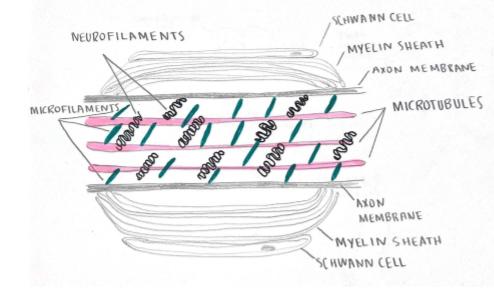
Function: The axon is a long, slender projection of a neuron responsible for transmitting electrical impulses, known as action potentials, from the neuron's axon hillock to the axon terminals. At the terminals, the signal is passed across the synapse to other neurons, muscles, or glands. The axon serves as the main communication highway for sending information efficiently over long distances in the nervous system.
Myelin Sheath: Many axons are wrapped in a protective, insulating layer called the myelin sheath, which is made up of specialized glial cells. The myelin sheath acts as an insulator, increasing the speed at which electrical impulses travel down the axon. Instead of moving continuously, the action potential "jumps" from one unmyelinated gap, known as the nodes of Ranvier, to the next. This allows signals to travel much faster compared to unmyelinated axons.
Cytoskeleton Structure: The axon is supported internally by a network of microtubules and neurofilaments. Microtubules in the axon are arranged with their plus (+) ends toward the axon terminal, allowing molecular motors like kinesins to transport cellular cargo outward, while dyneins transport cargo back toward the cell body in the negative direction. This transport system ensures the efficient movement of materials such as proteins, vesicles, and organelles within the axon.
Other Facts: Each neuron typically has only one axon, but this axon can branch into multiple terminals to communicate with other neurons (or itself!). The axon terminal contains synaptic vesicles that release neurotransmitters, the chemical signals that pass the electrical signal across the synapse to the next neuron.
Back to Neuron